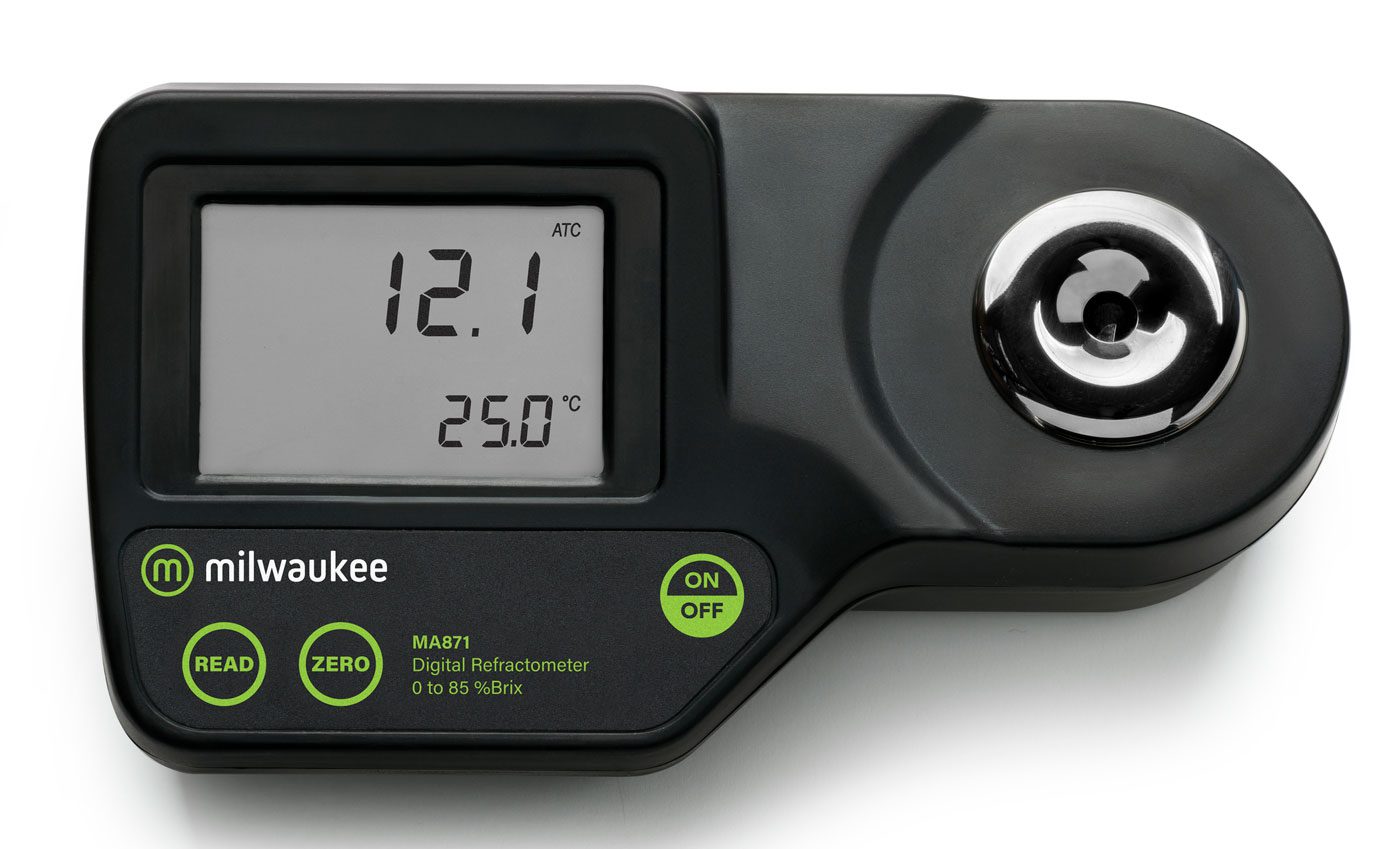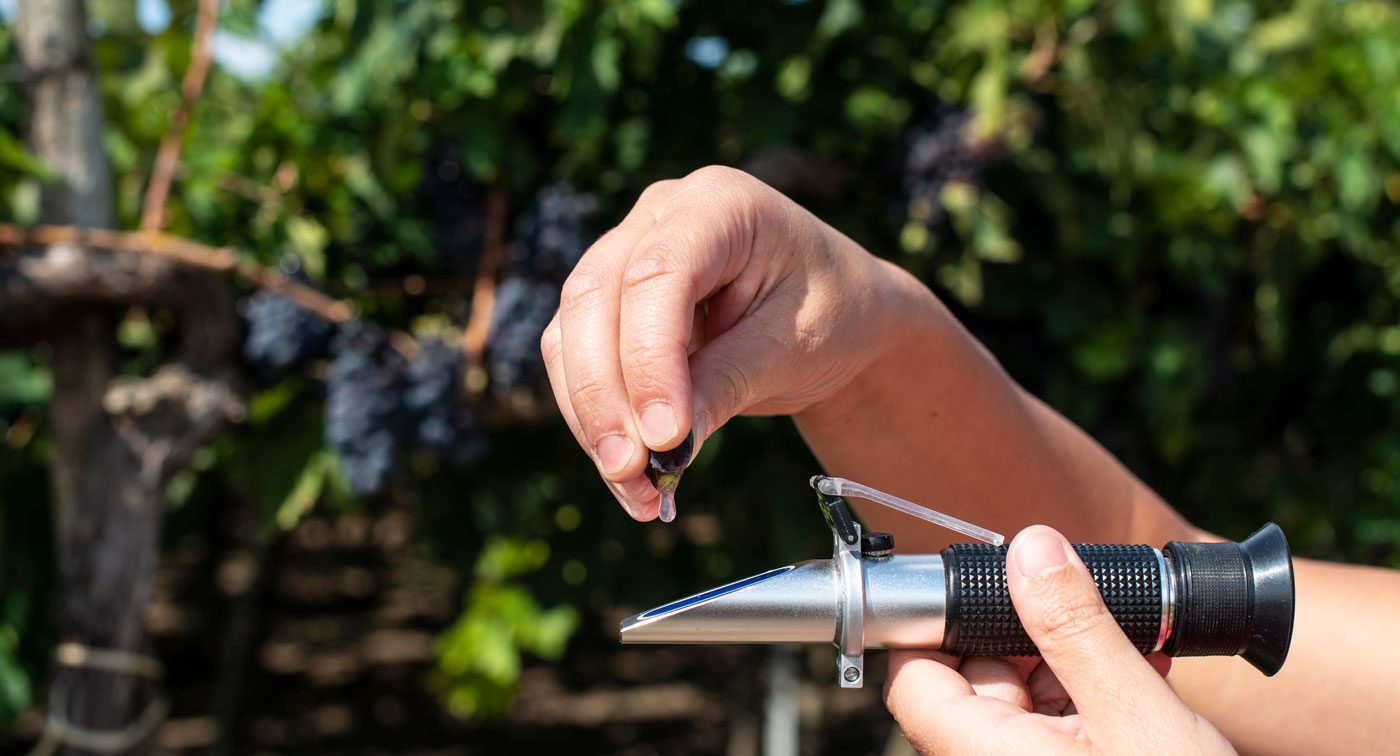The amount of sugar in a plant’s sap is one of many indicators of plant health. Measuring and comparing the Brix level of growing cannabis plants can also help determine which growing protocol changes are beneficial, and which are baneful. The Brix scale is named after 19th-century German scientist Adolf Brix, who utilized the hydrometer as an instrument to measure the sugar content of grape juice for wine. The abbreviation of Brix measurements is Bx.
Brix is the measure of sugar in an aqueous (water) solution measured as a percentage. For example: 1 gram of sucrose (sugar) added to 99 grams of water will result in 100 grams of solution at 1 degree of Brix. For another example: 50 grams of sucrose added to 50 grams of water would result in 100 grams of solution at 50 degrees Brix (a solution made of sugar and water in equal parts is also known as simple syrup). In practical usage, often the solution consists of not just water and sucrose but also other substances, which can skew the readings. Since an aqueous solution is rarely nothing but water and sugar, the readings from a Brix meter tend to be more an approximation than an absolute measure of sugar. This should be no surprise to garden enthusiasts who understand that EC meters (electrical conductivity) give the net conductivity of the solution and not the exact amount of any particular salt.
In gardening it is common knowledge that nutrient solutions can be measured with a variety of related scales such as EC, PPM (parts per million), and TDS (total dissolved solids). In a similar fashion (although using different principles), sugar levels can be described by not only Brix (Bx), but also degrees Plato (P), Balling (Blg), Baumé (B), Klosterneuburger (KMW), Ceskoslovensky Normalizovany Mostomer (CNM), and Oechsle (Oe). In the United States, Brix is the scale commonly used for vegetables, fruits, fruit juices, wines, and sodas. All other things being equal, fruit with a higher Brix (more sugar) will taste sweeter (and therefore be more desirable in most cases) than the same type of fruit with a lower Brix (less sugar).
Specific gravity (SG) was the original basis for Brix measurements when they were first developed in the 1800s. When measuring liquids, water is commonly used as the reference with a set value of 1. Things that are more dense than water will have a SG value greater than 1, and things that are less dense will have a value less than 1. Home brewers will commonly use a floating gauge called a hydrometer to find the specific gravity. In pure water, the gauge will float at a level marked “1,” which is the baseline. In less dense liquids, the gauge will float at a lower level. In a more dense liquid, it will float higher. Readings can be taken from the float to determine SG, which then in turn can be used to calculate an approximate Brix rating.

If the specific gravity of a liquid is known, then to estimate Brix degrees, subtract 1, multiply by 1,000, and divide by four (Bx = (SG – 1) x 1,000 ÷ 4). For example, if a liquid has a specific gravity of 1.060, then subtract 1 to get .060, multiply by 1,000 to find 60, and then divide by 4 for 15 degrees Brix.
While this is a common method used with homemade beverages, it requires enough liquid for the gauge to float in, which makes it generally unsuitable for measuring Brix in cannabis.
Refractometers use a different principle and are a more suitable choice for checking cannabis. They work using only a small sample of fluid, which is placed in a beam of light, and the amount of refraction (how much the light bends as it passes through) determines the Brix reading.
Optical Brix refractometers used for cannabis rely on eyesight to see where the dark edge falls across a scale. A drop is applied, pointed at a light source, and the reading taken. They tend to be quite a bit less expensive than digital refractometers, but are temperature sensitive to temperatures higher or lower than 68 °F (20 °C).
For improved accuracy, the results of any test not taken at 68 °F
(20 °C) can be adjusted with a temperature table such as the following simplified example:
If it’s 64 °F (18 °C), then subtract 0.1
68 °F (20 °C), then use value shown
72 °F (22 ºC), then add 0.1
75 °F (24 °C),then add 0.2
79 °F (26 °C), then add 0.4
For simplicity, readings that will be compared to each other can be taken at the same temperature or the allowable margin of error increased to account for a few tenths of a degree difference.
Digital Brix refractometers provide a digital readout display for ease of use and many automatically adjust for temperature, but they tend to be substantially more expensive. A drop of sap is placed on a prepared prism which is exposed to light and the device calculates and displays the results.
With either style of refractometer, it is important to occasionally calibrate with distilled or reverse osmosis (RO) water, and the sample plate should be cleaned after every use to preserve optical clarity.

While a high sugar content in the end product of cannabis harvest isn’t necessarily a goal in itself (unlike with fruits and vegetables) having plenty of sugar available in the sap can indicate health and good metabolic functioning in cannabis. Photosynthesis uses light energy and carbon dioxide to form sugars that can be used to grow and develop the plant. The reasoning behind measuring the Brix in cannabis plants is that if these sugar levels are high, then the plant is probably doing well and can be expected to be more productive than a cannabis plant with a low Brix measurement.
As an estimate, cannabis sap from a thriving mature cannabis plant should be higher than 12% (12 degrees Bx), rising at harvest to 15% or higher. Make sure that any refractometer used is capable of measuring Brix in at least this range (0–30 is not an uncommon range). Recording the Brix levels of cannabis plants over time can give a better feel for what levels are goals for each stage of development for a particular variety and what to expect from future grows.
Brix is best used as an indicator for fine tuning an already successful garden. If the leaves of the plant are all yellowing and dying, then it is obviously not doing well, and you don’t need a Brix test to tell you that. However, it can be helpful in dialing in methods to improve already healthy plants. Changes in the plant’s environment or nutrient solution that result in a higher Brix value are usually beneficial, whereas changes that decrease Brix may indicate the change is hindering. For example, if adding a particular additive to the nutrient solution causes a rise in Brix, then keep using it. If it drops, then consider discontinuing it. By judicious use and with competent records, a Brix refractometer can be a helpful addition to a gardener’s toolbox.
Grubbycup was raised on an organic dairy farm and has 40 years experience with personal use and larger gardens. Between writing, gardening, cooking, and raising cats; he also spends time with website programming, graphic design, and marketing for Tradewinds Wholesale Garden Supply.

